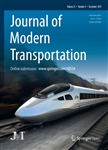Effects of soil profile and characteristic of exciting force on propagation of ground vibrations
Effects of soil profile and characteristic of exciting force on propagation of ground vibrations作者机构:Institute for Geo-Resources and Environment National Institute of Advanced Industrial Science and Technology1-1-1 Higashi Tsukuba Ibaraki 305-8567 Japan Kobayashi Institute of Physical Research3-20-41 Higashi-Motomachi Kokubunji Tokyo 185-0020 Japan Construction Engineering Research Institute Foundation1-3-10 Turukabuto Nada-ku Kobe Hyogo 657-0011 Japan
出 版 物:《Journal of Modern Transportation》 (现代交通学报(英文版))
年 卷 期:2012年第20卷第3期
页 面:129-137页
学科分类:12[管理学] 083002[工学-环境工程] 1204[管理学-公共管理] 120402[管理学-社会医学与卫生事业管理(可授管理学、医学学位)] 0830[工学-环境科学与工程(可授工学、理学、农学学位)] 08[工学] 0837[工学-安全科学与工程]
基 金:supported in part by the Minis-try of the Environment of Japan
主 题:ground-borne vibration vibration source exciting force stratified structure soil profile
摘 要:Ground-borne vibrations caused by vibration sources such as road traffic and construction exhibit complicated properties during propagation from the vibration source to the inside of a building. In the present paper, a numerical analysis technique for the system of vibration source and propagation path of ground vibration is developed in order to systematically determine the propagation properties of the vibration as part of developing a predictive technique for exposure evaluations by vibrations in three directions at receiving points of vibration in the human body. First, the exciting forces in three directions for input into the numerical computation are inversely-estimated by using the measured acceleration rec- ords of the measurement points, which are near the vibration source. The thin-layered element method is used for numerical computation of the ground vibration. Then, the calculation results for the ground vibration obtained by using the estimated exciting force are compared with the measured results, and the influence of the stratified structure of the ground on the exciting force and the propagation properties of the ground vibration are studied. From these results, in a prediction of the ground vibration in three directions, it is emphasized that it is necessary to consider the influence of horizontal exciting force, although attention has been paid to only the vertical exciting force for simulating ground vibration.



